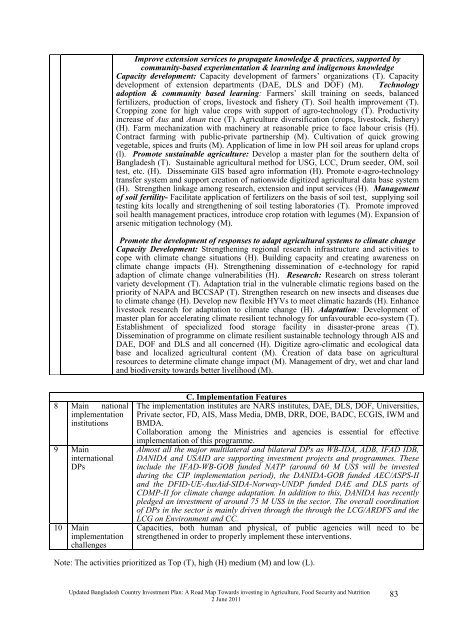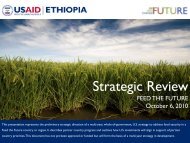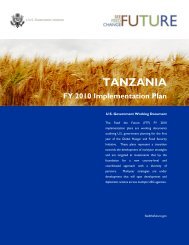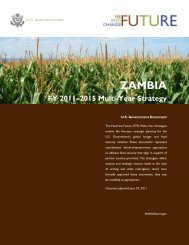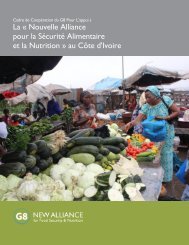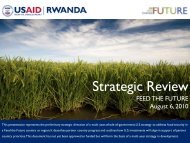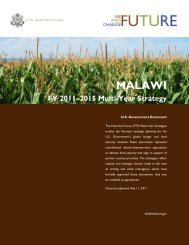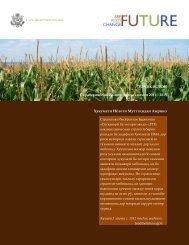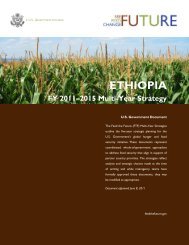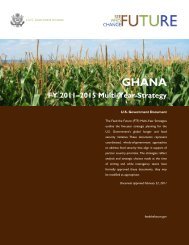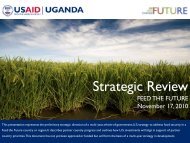Bangladesh Country Investment Plan - Feed the Future
Bangladesh Country Investment Plan - Feed the Future
Bangladesh Country Investment Plan - Feed the Future
You also want an ePaper? Increase the reach of your titles
YUMPU automatically turns print PDFs into web optimized ePapers that Google loves.
Improve extension services to propagate knowledge & practices, supported by<br />
community-based experimentation & learning and indigenous knowledge<br />
Capacity development: Capacity development of farmers’ organizations (T). Capacity<br />
development of extension departments (DAE, DLS and DOF) (M). Technology<br />
adoption & community based learning: Farmers’ skill training on seeds, balanced<br />
fertilizers, production of crops, livestock and fishery (T). Soil health improvement (T).<br />
Cropping zone for high value crops with support of agro-technology (T). Productivity<br />
increase of Aus and Aman rice (T). Agriculture diversification (crops, livestock, fishery)<br />
(H). Farm mechanization with machinery at reasonable price to face labour crisis (H).<br />
Contract farming with public-private partnership (M). Cultivation of quick growing<br />
vegetable, spices and fruits (M). Application of lime in low PH soil areas for upland crops<br />
(l). Promote sustainable agriculture: Develop a master plan for <strong>the</strong> sou<strong>the</strong>rn delta of<br />
<strong>Bangladesh</strong> (T). Sustainable agricultural method for USG, LCC, Drum seeder, OM, soil<br />
test, etc. (H). Disseminate GIS based agro information (H). Promote e -agro-technology<br />
transfer system and support creation of nationwide digitized agricultural data base system<br />
(H). Streng<strong>the</strong>n linkage among research, extension and input services (H). Management<br />
of soil fertility- Facilitate application of fertilizers on <strong>the</strong> basis of soil test, supplying soil<br />
testing kits locally and streng<strong>the</strong>ning of soil testing laboratories (T). Promote improved<br />
soil health management practices, introduce crop rotation with legumes (M). Expansion of<br />
arsenic mitigation technology (M).<br />
Promote <strong>the</strong> development of responses to adapt agricultural systems to climate change<br />
Capacity Development: Streng<strong>the</strong>ning regional research infrastructure and activities to<br />
cope with climate change situations (H). Building capacity and creating awareness on<br />
climate change impacts (H). Streng<strong>the</strong>ning dissemination of e -technology for rapid<br />
adaption of climate change vulnerabilities (H). Research: Research on stress tolerant<br />
variety development (T). Adaptation trial in <strong>the</strong> vulnerable climatic regions based on <strong>the</strong><br />
priority of NAPA and BCCSAP (T). Streng<strong>the</strong>n research on new insects and diseases due<br />
to climate change (H). Develop new flexible HYVs to meet climatic hazards (H). Enhance<br />
livestock research for adaptation to climate change (H). Adaptation: Development of<br />
master plan for accelerating climate resilient technology for unfavourable eco-system (T).<br />
Establishment of specialized food storage facility in disaster-prone areas (T).<br />
Dissemination of programme on climate resilient sustainable technology through AIS and<br />
DAE, DOF and DLS and all concerned (H). Digitize agro -climatic and ecological data<br />
base and localized agricultural content (M). Creation of data base on agricultural<br />
resources to determine climate change impact (M). Management of dry, wet and char land<br />
and biodiversity towards better livelihood (M).<br />
8 Main national<br />
implementation<br />
institutions<br />
9 Main<br />
international<br />
DPs<br />
10 Main<br />
implementation<br />
challenges<br />
C. Implementation Features<br />
The implementation institutes are NARS institutes, DAE, DLS, DOF, Universities,<br />
Private sector, FD, AIS, Mass Media, DMB, DRR, DOE, BADC, ECGIS, IWM and<br />
BMDA.<br />
Collaboration among <strong>the</strong> Ministries and agencies is essential for effective<br />
implementation of this programme.<br />
Almost all <strong>the</strong> major multilateral and bilateral DPs as WB-IDA, ADB, IFAD IDB,<br />
DANIDA and USAID are supporting investment projects and programmes. These<br />
include <strong>the</strong> IFAD-WB-GOB funded NATP (around 60 M US$ will be invested<br />
during <strong>the</strong> CIP implementation period), <strong>the</strong> DANIDA-GOB funded AEC/ASPS-II<br />
and <strong>the</strong> DFID-UE-AusAid-SIDA-Norway-UNDP funded DAE and DLS parts of<br />
CDMP-II for climate change adaptation. In addition to this, DANIDA has recently<br />
pledged an investment of around 75 M US$ in <strong>the</strong> sector. The overall coordination<br />
of DPs in <strong>the</strong> sector is mainly driven through <strong>the</strong> through <strong>the</strong> LCG/ARDFS and <strong>the</strong><br />
LCG on Environment and CC.<br />
Capacities, both human and physical, of public agencies will need to be<br />
streng<strong>the</strong>ned in order to properly implement <strong>the</strong>se interventions.<br />
Note: The activities prioritized as Top (T), high (H) medium (M) and low (L).<br />
Updated <strong>Bangladesh</strong> <strong>Country</strong> <strong>Investment</strong> <strong>Plan</strong>: A Road Map Towards investing in Agriculture, Food Security and Nutrition<br />
2 June 2011<br />
83


